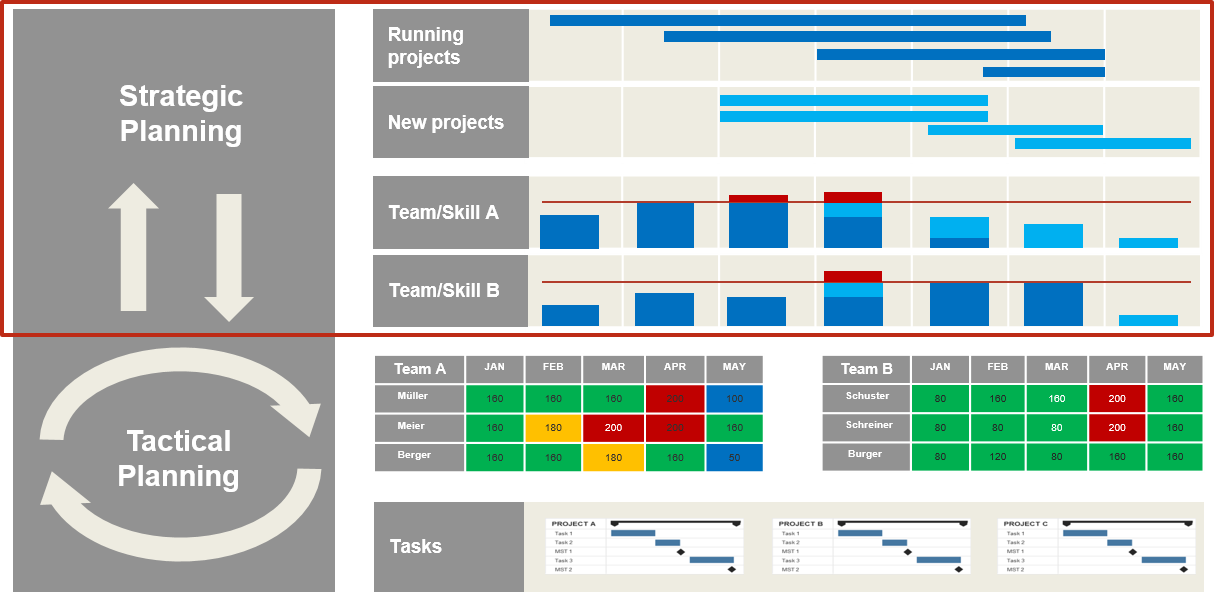Capacity Planning is the process in which organizations or teams match available employee hours against the needs of a project or program.
To be more specific, capacity here means the maximum amount of work that can be completed in a given period. And in this context, “planning” is the act of scheduling employee hours against a fixed or expected amount of work.

Capacity Planning can help you ramp up your resource output by manifolds.
What does it mean for different people?
For the people who manage projects, it can mean to be:
Allocate available resources to projects in the right amounts and also requesting for more as per analysed need.
Adding, updating and removing resource requests for resources as per the project permits. Capacity planning for the resources can be done on an hourly, daily, monthly or weekly basis.
For the Resource/Portfolio Manager
Analyze Capacity and demand. Relocate resources across multiple projects and assess the needs raised by project managers, approve or disapprove resource requests as per the organisation's best interests.
Directly assign resources to various projects based on their work capacity and general occupancy on the job and given assignments.
Do resource utilisation forecasting for projects lying in the organisation's pipeline.
The capacity planning lifecycle:

To make things easier for you:
Define Resource Groups - Defining a pod of resources who can be allocated to a certain incoming project or a certain type of project should be done beforehand. This is very much in line with your organisational goals.
Set up primary groups and users - Always keep a set of people who will be prime to a certain category of projects. Assign the resource manager role to someone who should be in charge of shuffling or allocation of resources, capacity checks and resource bandwidth individually.
What's the end goal of capacity planning?
Proper resource utilisation and minimal time wastage in ongoing operations while delivering sheer excellence in terms of quality and quality to the service seeking business. The ultimate goal of capacity planning is to meet the current and future level of the requirement at a minimal wastage. The three types of capacity planning based on goal are lead capacity planning, lag strategy planning and match strategy planning.

How to strategically think the factors and practises which help:
Your resource availability, your business's deliverables, as a service or a product and your ability to handle your resources productively. All these factors bring together your capacity planning forecast and they should be thought through using resource optimisation techniques like:
- Agile - Agile software development refers to a group of software development methodologies based on iterative development, where requirements and solutions evolve through collaboration between self-organizing cross-functional teams.
- Scrum - Scrum is a subset of Agile. It is a lightweight process framework for agile development, and the most widely-used one.
- Jira (Tool) - Jira is a project management tool used to maintain transparency across all stakeholders project members.
- RACI - This acronym 'RACI' stands for the four roles that stakeholders perform in any given project, regardless of its scale. The RACI matrix is a responsibility assignment chart that maps out every task, milestone or key decision involved in completing a project and assigns which roles are Responsible for each action item, which personnel are Accountable, and, where appropriate, who needs to be Consulted or Informed.
What are the exact factors into consideration in strategizing every capacity plan; maybe long term or short term.
- Your work culture and dynamics within teams and project stakeholders.
- Your area of business or services
- Number of projects you can accommodate at full team capacity
- Number of resources you require at any given moment.
- Duration of projects and the Return on Investment.
About bottlenecks and critical paths
What can be a bottleneck? A simple chunk of any process having comparatively limited capacity than the rest of the processes which in the end reduces the capacity of the overall process. It can be a particular resource pool, or a particular decision maker or a specific.
The crunching of numbers, or the advisory analysis? With well-defined processes, hold-ups should be apparent.
Working through these issues will make your capacity planning more and more efficient with time. Fixing your bottlenecks is the first thing you want to do. Fixing or improving throughput in your bottlenecks will likely have the biggest impact in your capacity, by two ways, either it will dramatically improve resource productivity or improve timely completion of projects.
Understanding the processes that can crisscross your organization from start to finish can uncover how processes overlap one another and share resources. One method to do this is via the critical path, which is the longest sequence of activities that must be finished on time for the project to be completed by the due date.
Make sure you are collecting and organising project data
First, you register all projects with the essential information in a central database. This requires details such as:
- Project’s name
- Who’s the Project Manager
- Are there any sponsors for the
- Project Kickoff / Initiation
- Project Closure Day/ Hand over or Knowledge Transfer.
- Some traffic light indicators for status and truck indicators.
If you don’t do this right, it might be very difficult to make sure you are making well-informed decisions and it will lead to poor organisation of resources and always deter the movement of sprints.
Identify actually available resources
It would not make sense to analyse each resource individually, rather does it makes sense to make sure does not make sense to analyse the project and the team’s output on the particular project. While this would be desirable, it would be too much effort.
Displaying the total capacity of all employees in one chart is not wise either. Employees have different skills which you have to deploy as required.

The only way you can actually identify resources is making them fall under a pool of skill-sets and then check their occupancy on several projects. This will help you identify them and allocate to projects wisely.
The remainder
First to-do: Clearly Establish all legacy processes with the appropriate staff, from top management to team leaders, department heads and project managers through to the PMO.
Secondly, always provide for complete and up-to-date project data and prioritize your projects with absolute involvement from management.
Third, keep meeting the stakeholders and the deployed team concurrently to make sure that it is very much in line with expectations across the aisle.
Always try to identify consolidated and forthcoming unforeseen requirements and the entire team bandwidth. Identify underworked teams and overloaded teams to always maintain equilibrium across both sides of the project. This will help in not hampering productivity.
In addition, you have learned about two further important parameters. These can make for successful resource capacity planning in project management. You can always reach out to us for consulting us on the above practices, also we can help your team is low on bandwidth.
Subscribe
Related Blogs
Trek n Tech Annual Retreat 2025: A 7-Day Workcation of OSL

OSL family came together for the Trek n Tech Annual Retreat 2025, a 7-day workcation set amidst the serene beauty of…
Exploring Drupal's Single Directory Components: A Game-Changer for Developers

Web development thrives on efficiency and organisation, and Drupal, our favourite CMS, is here to amp that up with its…
7 Quick Steps to Create API Documentation Using Postman

If you work with API , you are likely already familiar with Postman, the beloved REST Client trusted by countless…




